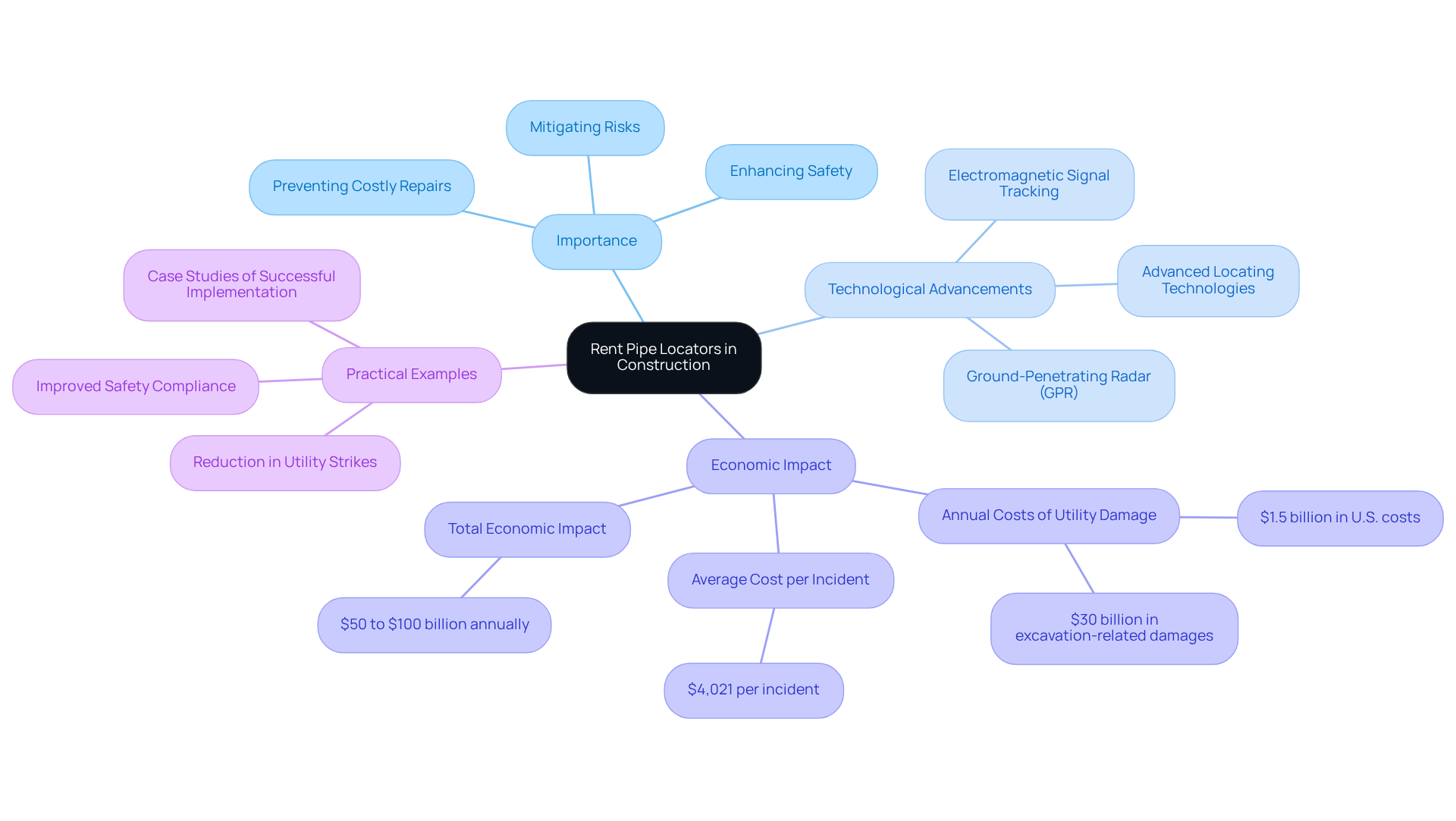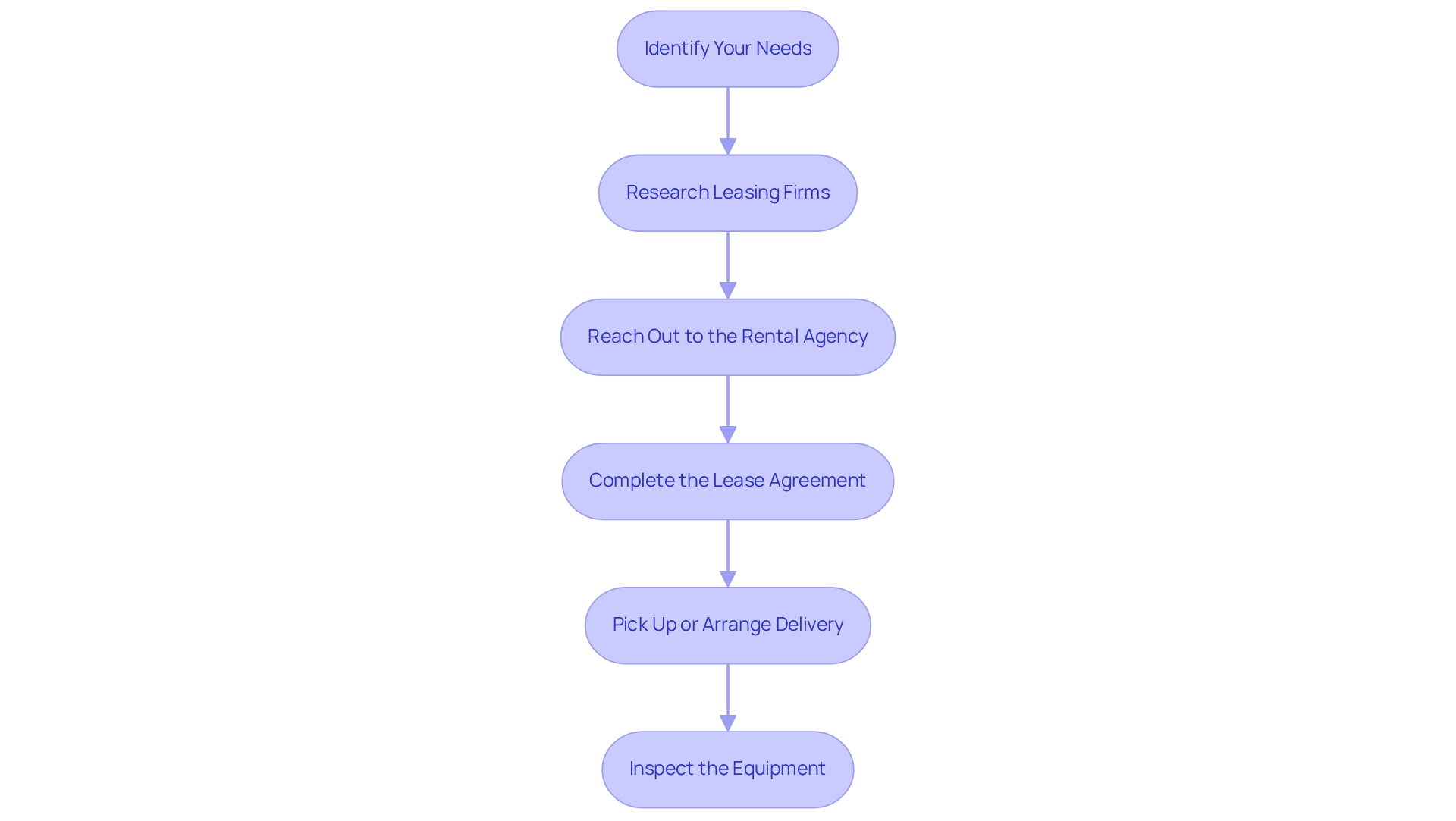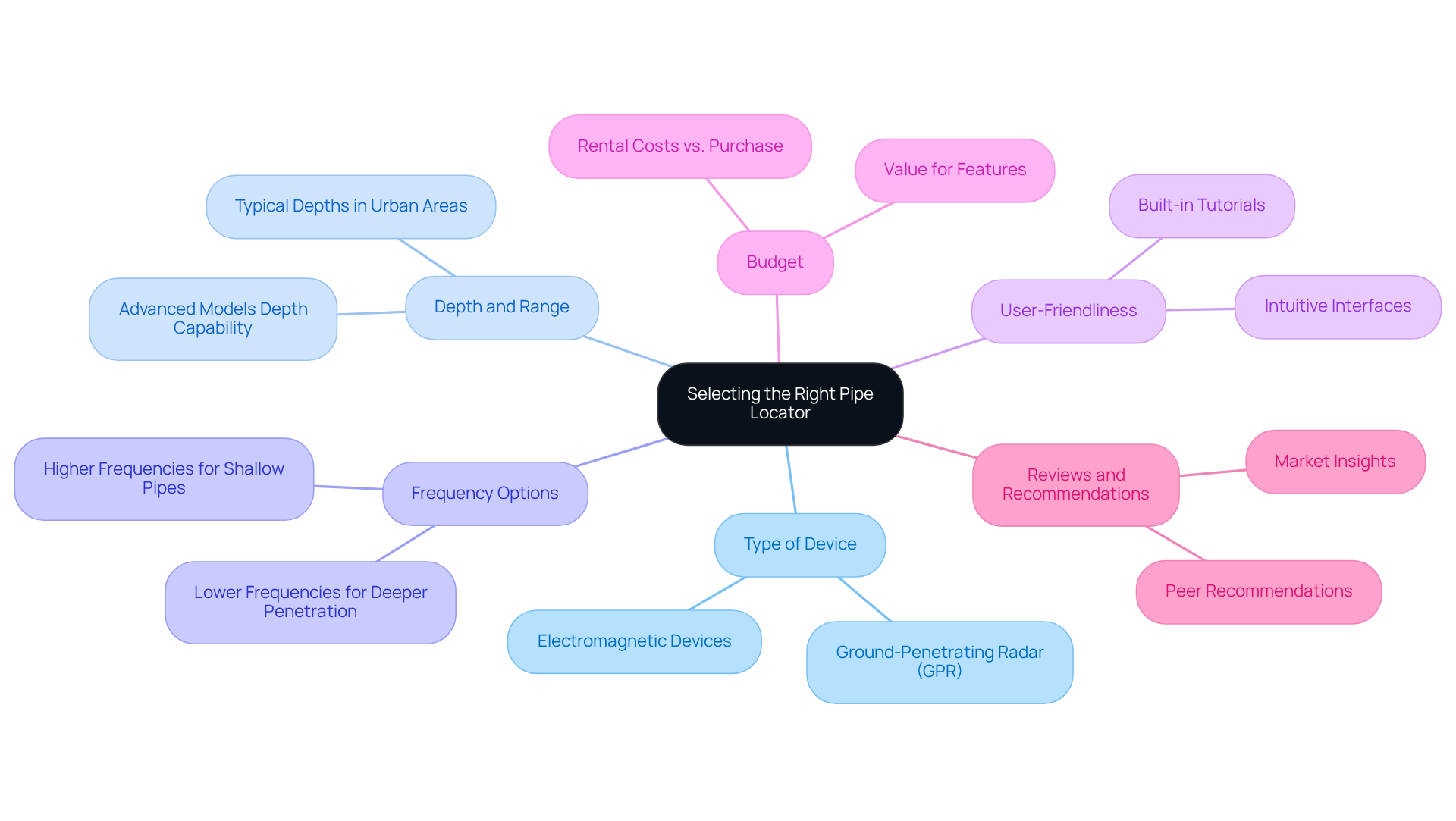Overview
The article outlines a four-step process for renting a pipe locator for construction projects, emphasizing the critical role these devices play in preventing costly damage to underground utilities.
- First, it is essential to identify project needs, which sets the foundation for selecting the appropriate equipment.
- Next, researching rental firms ensures that you find reliable providers who offer quality tools.
- Completing lease agreements is the third step, where clarity in terms and conditions is vital for a smooth rental experience.
- Finally, inspecting equipment before use guarantees that you are equipped with reliable tools that enhance safety and efficiency on job sites.
The financial implications of utility strikes cannot be overstated. Such incidents can lead to significant costs and project delays, making the use of advanced locating technologies not just beneficial but essential. These technologies not only improve the accuracy of locating underground utilities but also contribute to a safer working environment. Furthermore, investing in quality equipment from reputable rental firms ensures that your projects run smoothly and efficiently.
In conclusion, understanding the process of renting a pipe locator is crucial for any construction project. By following these four steps—identifying needs, researching firms, completing agreements, and inspecting equipment—you can significantly mitigate risks associated with underground utilities. Take action today to enhance your project’s safety and efficiency by renting the right equipment.
Key Highlights:
- A rent pipe locator is crucial for locating underground utilities, reducing risks of costly damages during excavation.
- In the U.S., underground utility damage costs approximately $1.5 billion annually, with excavation-related damages reaching about $30 billion in 2019.
- Advanced locating technologies significantly decrease utility strikes, enhancing safety and operational efficiency.
- To rent a pipe locator, identify project needs, research leasing firms, inquire about equipment, complete lease agreements, and inspect the equipment before use.
- Selecting the right pipe locator involves considering device type, depth capability, frequency options, user-friendliness, budget, and professional recommendations.
- Common issues when renting a pipe locator include equipment malfunctions, signal interference, incorrect readings, user confusion, and return issues; each can be resolved with proper troubleshooting steps.
Introduction
Understanding the intricate web of underground utilities is paramount for any construction project. The hidden infrastructure poses significant risks that can lead to costly setbacks. With accidental utility strikes resulting in staggering costs—amounting to billions annually—construction teams must prioritize effective tools for locating these vital conduits.
The challenge, however, lies in selecting the right pipe locator from a myriad of options and ensuring an efficient rental process. How can project managers navigate this landscape to safeguard their operations and minimize costly delays? By employing reliable equipment and strategic planning, they can mitigate risks and enhance project efficiency.
Understand Pipe Locators and Their Importance in Construction
A rent pipe locator serves as an essential instrument for pinpointing the location of subterranean tubes and utilities, utilizing electromagnetic signals to track hidden infrastructure. Recent advancements in technology, notably the emergence of ground-penetrating radar (GPR) devices, have markedly improved the accuracy and efficiency of these tools. Understanding the various types of conduit finders available allows project managers to select the most suitable option for their specific needs.
The importance of utilizing a rent pipe locator as a conduit finder cannot be overstated; it plays a pivotal role in mitigating the risk of costly repairs and project delays. In the U.S., damage to underground utilities incurs an economic cost of approximately $1.5 billion annually, with excavation-related damages alone amounting to about $30 billion in 2019. These figures underscore the financial ramifications of striking underground utilities during excavation work, where the average cost per incident can soar to $4,021. Furthermore, the total economic impact of underground utility damage is estimated to range between $50 to $100 billion annually in the U.S.
Practical examples illustrate the effectiveness of using a rent pipe locator in preventing damage. For example, construction projects that adopted advanced locating technologies reported a substantial decrease in utility strikes, resulting in smoother operations and improved safety compliance. By using a rent pipe locator to accurately identify the location of conduits, construction crews can streamline their tasks, ensuring adherence to safety standards and minimizing the likelihood of incidents. This proactive strategy not only safeguards existing infrastructure but also encourages the use of a rent pipe locator to cultivate a safer working environment for all involved. Notably, 49.3 million Americans plan to excavate without contacting 811, emphasizing the critical need for awareness and the role of utility finders in preventing harm. Additionally, failing to notify the one-call center (811) accounts for 29% of damages, further reinforcing the importance of employing underground utility finders.

Follow the Step-by-Step Rental Process for Pipe Locators
To rent a pipe locator effectively, follow these essential steps:
-
Identify Your Needs: Begin by evaluating the specific requirements for your project. Consider the type of conduit finder needed based on factors such as depth, material composition, and site complexity.
-
Research Leasing Firms: Look for reputable equipment leasing providers, such as EZ Equipment Leasing. Examine their inventory for available pipe locators and consider the option to rent pipe locator while comparing leasing rates and terms to find the best fit for your project.
-
Reach Out to the Rental Agency: Inquire about the availability of the desired equipment, along with leasing terms and pricing. Provide detailed information about your project to ensure you receive the most suitable conduit finder.
-
Complete the Lease Agreement: Once you have chosen a rent pipe locator, finalize the lease agreement. This process typically involves providing identification, payment information, and consenting to the leasing terms.
-
Pick Up or Arrange Delivery: Decide whether to collect the equipment from the leasing location or have it delivered to your job site. If you opt for pickup, ensure you have appropriate transportation ready.
-
Inspect the Equipment: Before use, thoroughly inspect the pipe locator for any damage and verify its functionality. Familiarize yourself with its operation by reviewing the user manual or requesting a demonstration from the staff.
By following these steps, you can streamline the rental process and ensure you have the right equipment for your construction project.

Select the Right Pipe Locator for Your Project Needs
Selecting the appropriate pipe locator for your construction project demands meticulous evaluation of several critical factors:
-
Type of Device: Determine whether to employ electromagnetic devices, adept at detecting metallic conduits, or ground-penetrating radar (GPR) tools, which can identify both metallic and non-metallic conduits. GPR is especially beneficial in urban environments where a variety of materials coexist.
-
Depth and Range: Analyze the typical depth of concealed conduits in urban construction zones, often reaching depths of 20 feet or more. It is essential to choose a device that can proficiently detect conduits at these depths, as some advanced models can locate utilities buried up to 18 feet deep.
-
Frequency Options: Different devices operate at varying frequencies, impacting their effectiveness. Higher frequencies provide superior resolution for shallow pipes, while lower frequencies allow for deeper penetration but may compromise detail. For example, the Pipehorn 800H can detect frequencies up to 480 kHz, making it suitable for challenging conditions.
-
User-Friendliness: Consider the ease of use of the device. Models with intuitive interfaces and built-in tutorials are ideal for users with diverse experience levels, ensuring efficient on-site operation. The Schonstedt Loki, for instance, is lightweight and offers multiple frequency options, enhancing usability.
-
Budget: Evaluate rental costs in relation to your project budget. Identifying a rent pipe locator that offers exceptional value for its features is crucial, especially given the significant initial expenses associated with advanced tools. The Pipe Utility Locators Market is projected to reach USD 2.5 billion by 2033, underscoring the growing significance of selecting the right equipment.
-
Reviews and Recommendations: Actively seek reviews or recommendations from fellow construction professionals. Recognizing reliable models that have excelled in similar applications can streamline your selection process and improve project outcomes. According to the National Association of Underground Utility Locating Contractors, the global pipeline locating services market was valued at USD 1.2 billion in 2021, emphasizing the necessity of effective utility locating technologies.
By thoroughly evaluating these factors, you can select a conduit finder that meets your project specifications, ensuring efficient and safe excavation while minimizing the risk of utility strikes.

Troubleshoot Common Issues When Renting a Pipe Locator
When you rent a pipe locator, several common issues may arise. Here’s how to effectively troubleshoot them:
-
Equipment Malfunction: If the locator fails to operate correctly, first check the battery level to ensure it is fully charged. If the issue persists, contact the rental company for assistance or a replacement. Notably, 40.2% of fleet managers reported raising maintenance budgets to prolong the lifespan of machinery, underscoring the significance of timely action to reduce project delays resulting from malfunctions.
-
Signal Interference: Inconsistent readings may result from signal interference caused by nearby utilities or environmental factors. To alleviate this, move to another location or modify the frequency settings on the device to lessen interference.
-
Incorrect Readings: If the device provides incorrect readings, verify that the equipment is calibrated correctly. Consult the user manual for calibration instructions and perform a test locate on a known pipe to confirm accuracy. Proper maintenance and calibration are crucial; improper settings can lead to costly errors on-site.
-
User Confusion: If you are unsure about using the rented pipe locator, consult the user manual or ask for a demonstration from the staff. Numerous leasing companies offer training sessions to ensure users are comfortable with the equipment.
-
Return Issues: Familiarize yourself with the leasing company’s return policy. If you face any problems during the lease duration, contact the leasing company quickly to prevent incurring extra fees. Understanding these policies can help prevent misunderstandings and ensure a smooth rental experience.
As Josh Nickell, Vice President of the American Rental Association’s machinery segment, emphasizes, "You can’t just assume that there’s a piece of machinery on your lot or hope one will be back in time; you have got to do a lot more planning, and use analytics to forecast what your needs are going to be." This underscores the importance of being proactive in equipment management.

Conclusion
Utilizing a rent pipe locator is essential in the construction industry, as it significantly mitigates the risk of damaging underground utilities during excavation. Accurately identifying the location of hidden pipes and conduits enhances project efficiency and safeguards against costly repairs and delays. The selection of appropriate equipment is critical; it directly influences the success of construction projects and the overall safety of the site.
This article outlines a comprehensive step-by-step process for renting a pipe locator, emphasizing the necessity of understanding project requirements, researching reputable rental agencies, and ensuring proper equipment inspection before use. Key factors, including the type of device, depth capabilities, user-friendliness, and budget considerations, play a pivotal role in making an informed choice. Furthermore, troubleshooting common issues associated with pipe locators can prevent project disruptions and bolster user confidence in the equipment.
In conclusion, the effective use of pipe locators not only streamlines construction processes but also cultivates a culture of safety and responsibility within the industry. By prioritizing the rental of suitable equipment and adhering to best practices, construction professionals can minimize risks and ensure successful project outcomes. Embracing these tools and strategies is vital for anyone involved in construction, as they facilitate safer, more efficient excavation practices.
Frequently Asked Questions
What is a rent pipe locator and how does it work?
A rent pipe locator is an essential instrument used to pinpoint the location of subterranean tubes and utilities by utilizing electromagnetic signals to track hidden infrastructure.
What advancements have been made in pipe locating technology?
Recent advancements include the emergence of ground-penetrating radar (GPR) devices, which have significantly improved the accuracy and efficiency of locating tools.
Why is it important to use a rent pipe locator in construction?
Using a rent pipe locator is crucial for mitigating the risk of costly repairs and project delays, as it helps prevent damage to underground utilities, which can incur significant economic costs.
What are the financial implications of damaging underground utilities during excavation?
In the U.S., damage to underground utilities costs approximately $1.5 billion annually, with excavation-related damages alone amounting to about $30 billion in 2019. The average cost per incident can reach up to $4,021.
How does using a rent pipe locator impact construction projects?
Construction projects that utilize advanced locating technologies report a significant decrease in utility strikes, leading to smoother operations and improved safety compliance.
What are the broader economic impacts of underground utility damage?
The total economic impact of underground utility damage in the U.S. is estimated to range between $50 to $100 billion annually.
What is the significance of contacting 811 before excavation?
Notably, 49.3 million Americans plan to excavate without contacting 811, highlighting the critical need for awareness about utility finders. Failing to notify the one-call center accounts for 29% of damages, reinforcing the importance of using underground utility finders.




